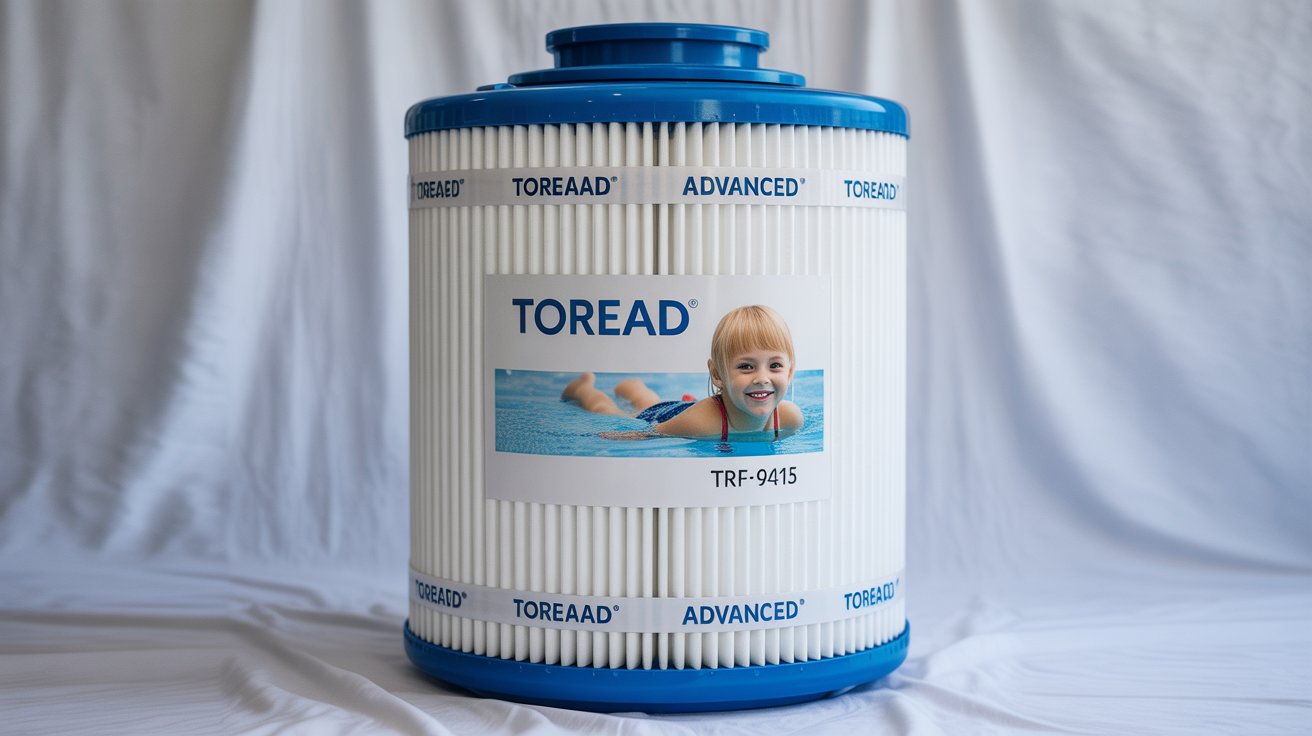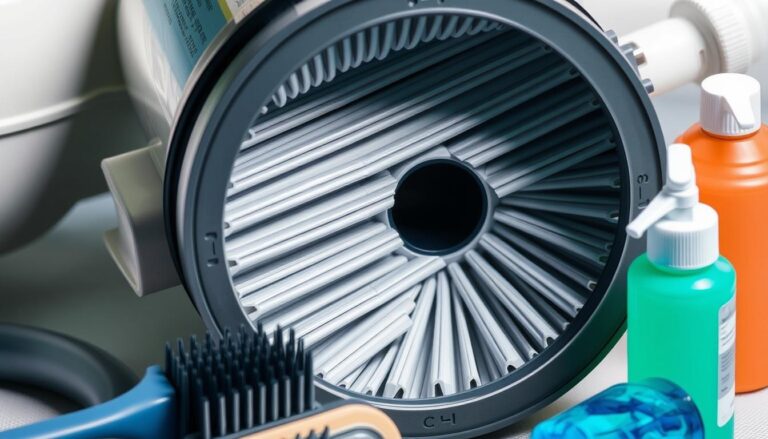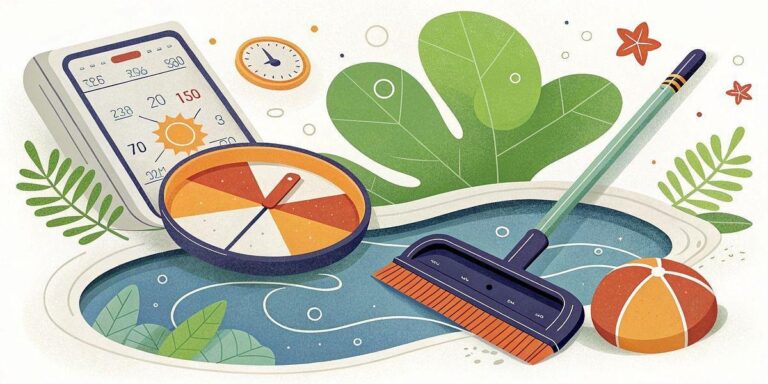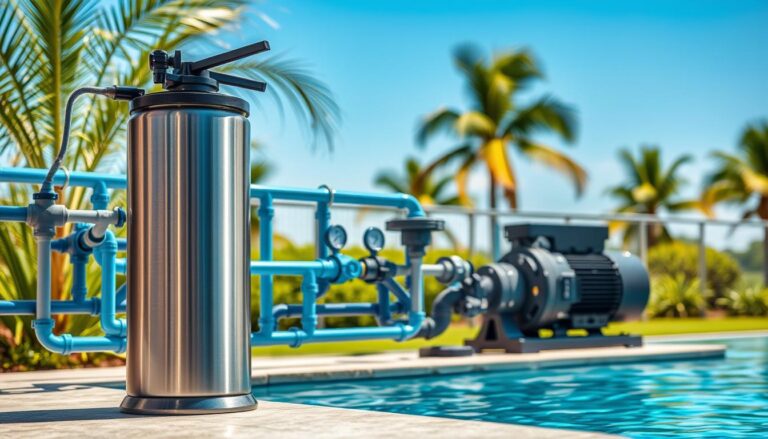The Best Method for Cleaning Pool Cartridge Filters
Are you tired of cloudy pool water and high maintenance costs? Cleaning your pool cartridge filters is a crucial step in maintaining a safe and healthy swimming environment.
Efficient filter cleaning not only improves water clarity but also extends the lifespan of your filters, saving you money in the long run. But, are you doing it right?
Proper maintenance of your pool’s filtration system is vital. In this article, we’ll explore the best practices for cleaning pool cartridge filters, ensuring your pool remains sparkling clean and safe for everyone.
Key Takeaways
- Regular cleaning improves filter efficiency
- Proper maintenance extends filter lifespan
- Dirty filters can lead to cloudy water
- Cleaning methods may vary depending on filter type
- Regular inspection is crucial for optimal performance
Understanding Pool Cartridge Filters
Cartridge filters are widely used in pool systems due to their effectiveness in trapping debris and contaminants. They are a popular choice among pool owners due to their efficiency and cost-effectiveness in maintaining clean and safe pool water.
How Cartridge Filters Work
Cartridge filters use a cylindrical fan-folded polyester cartridge as the water filtering medium. This design allows for effective trapping of debris and contaminants, ensuring that the pool water remains clean and clear. Understanding how cartridge filters work is crucial for effective maintenance and pool filter cleaning tips.
Types of Pool Cartridge Filters
There are various types of cartridge filters available, each designed for specific pool sizes and types. Understanding the type of filter you have is essential for proper cleaning and maintenance, ensuring that your pool remains safe and clean for swimmers.
Benefits Over Other Filter Types
Cartridge filters offer several benefits over other filter types, including ease of maintenance and effective filtration. They are preferred by many pool owners due to their efficiency and cost-effectiveness in the long run, making them a valuable component of pool cartridge filter maintenance.
By understanding the mechanics and benefits of cartridge filters, pool owners can better maintain their pool systems, ensuring clean and safe water for swimmers.
Why Regular Cleaning Is Essential
The effectiveness of your pool’s filtration system depends heavily on regular cleaning of the cartridge filter. A dirty filter can lead to a multitude of issues, including decreased water quality and increased energy consumption.
Signs Your Filter Needs Cleaning
Regular cleaning is crucial for maintaining the effectiveness of your cartridge filter. Signs that your filter needs cleaning include increased pressure gauge readings and decreased water flow. For instance, if your pressure gauge reading increases by 8-10 PSI, it’s a clear indication that your filter needs attention.
As emphasized by pool maintenance experts, “Regular filter cleaning is not just a recommendation, it’s a necessity for a healthy pool environment.”
Impact on Water Quality and Circulation
A dirty filter can significantly impact water quality and circulation, leading to cloudy water and potential health risks. Regular cleaning ensures that your pool water remains clean and safe for swimming. Proper maintenance also helps in maintaining the aesthetic appeal of your pool.
Consequences of Neglected Maintenance
Neglecting filter maintenance can result in costly repairs, replacement, and potential health hazards. It’s essential to stay on top of filter cleaning to avoid these issues. As a general rule, filters should be cleaned when the pressure gauge reading increases by 8-10 PSI, indicating a need for immediate attention.
By adopting a regular cleaning schedule, you can extend the lifespan of your cartridge filter and ensure your pool remains a safe and enjoyable space.
Tools and Supplies You’ll Need
Before you start cleaning your pool cartridge filter, it’s crucial to gather the necessary tools and supplies. Having everything you need within reach will make the process more efficient and ensure that your filter is cleaned effectively.
Essential Cleaning Equipment
To clean your cartridge filter effectively, you’ll need specific tools and supplies. The most essential items include a garden hose with a spray nozzle, cleaning solutions, and a large bucket.
Garden Hose Attachments
A garden hose with a suitable spray nozzle is essential for rinsing the filter. The nozzle should be able to provide a strong, focused stream of water to dislodge debris.
Tip: Look for a nozzle with multiple spray settings to adjust the water pressure according to your needs.
Cleaning Solutions
Various cleaning solutions are available, including TSP (Trisodium Phosphate) and commercial filter cleaners. The choice of solution depends on the type of debris and contaminants present in your filter.
- TSP is effective against grease and grime.
- Commercial cleaners are specifically designed for cartridge filters and are often gentler on the filter material.
Optional Tools for Deep Cleaning
For more thorough cleaning, additional tools such as filter cleaning wands and soaking containers can be useful.
Filter Cleaning Wands
These wands are designed to reach between the pleats of the filter, ensuring a more thorough clean. They are especially useful for filters with deep pleats or heavy contamination.
Soaking Containers
Soaking the filter in a cleaning solution can help loosen stubborn debris. A large bucket or container is necessary for this process.
Note: Ensure the container is large enough to hold the filter and enough cleaning solution to cover it completely.
| Tool/Supply | Purpose |
|---|---|
| Garden Hose with Spray Nozzle | Rinsing the filter |
| Cleaning Solutions (TSP, Commercial Cleaners) | Removing debris and contaminants |
| Filter Cleaning Wands | Deep cleaning between filter pleats |
| Soaking Containers | Soaking the filter in cleaning solution |
By having the right tools and supplies, you’ll be well-equipped to clean your pool cartridge filter effectively, ensuring your pool remains clean and safe for swimming.
Preparation Steps Before Cleaning
To ensure a safe and successful cleaning process, several preparation steps must be taken. Before you start cleaning your cartridge filter, it’s crucial to prepare your pool and the surrounding area.
Safety Precautions
Turning off the pool pump is the first and most critical safety precaution. This ensures that the system is not under pressure and reduces the risk of injury. Additionally, wearing protective gear such as gloves and safety glasses is recommended when handling cleaning chemicals.
Shutting Down Your Pool System
Ensure that the pool pump is turned off and the system is depressurized. This step is vital for safety and to prevent any damage to the filter or other equipment.
Accessing Your Filter Housing
You will need to access the filter housing, which may involve removing clamps or other fasteners. Consult your owner’s manual for specific instructions, as the process can vary depending on the model.
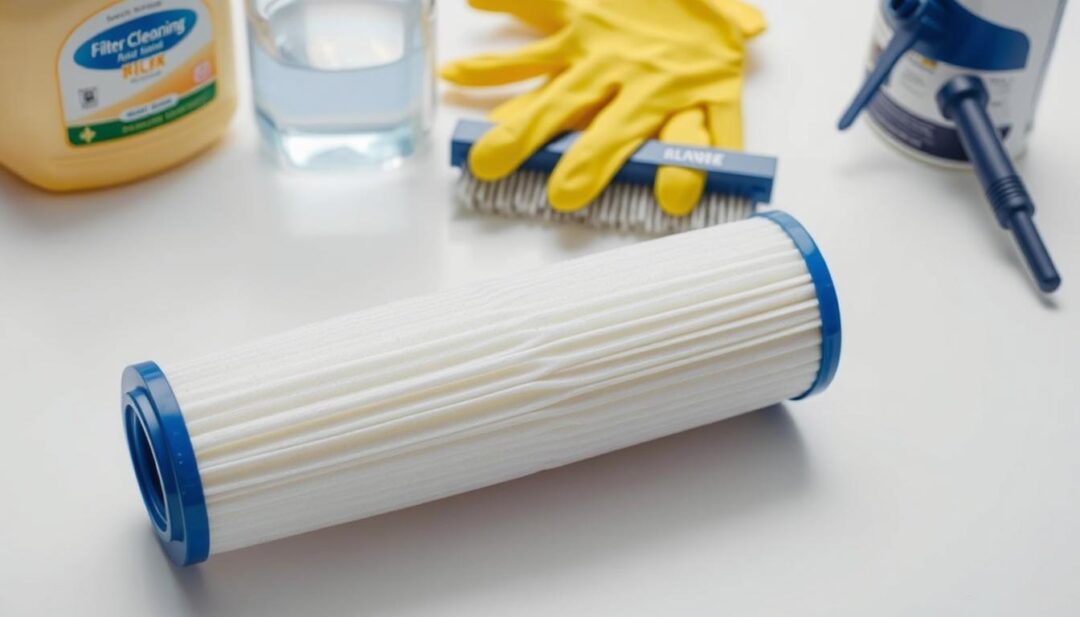
By following these preparation steps, you can ensure a safe and effective cleaning process for your cartridge filter, maintaining your pool’s health and longevity.
What Is the Best Way to Clean Pool Cartridge Filters
To keep your pool water sparkling clean, it’s essential to know the best methods for cleaning your cartridge filter. Cleaning your pool cartridge filter is a crucial task that ensures the overall health and safety of your pool environment.
Standard Rinse Method
The initial step in cleaning involves rinsing the filter with a garden hose to remove loose debris. This method is straightforward and effective for maintaining your filter’s performance.
Proper Angle and Pressure
It’s essential to use the correct angle and pressure when rinsing to avoid damaging the filter. Using too much pressure can tear the filter material, so it’s crucial to find the right balance.
Working from Top to Bottom
Start rinsing from the top of the filter and work your way down to ensure that debris is washed away effectively. This technique helps prevent dirt from being pushed further into the filter.
Deep Cleaning with Chemical Solutions
For more thorough cleaning, using chemical solutions such as TSP can help remove stubborn contaminants. These solutions are particularly useful when the filter is heavily soiled.
TSP and Muriatic Acid Options
TSP is effective for removing grease and grime, while muriatic acid can help dissolve mineral deposits. Always follow the manufacturer’s instructions when using these chemicals to avoid damage or harm.
Commercial Filter Cleaners
There are various commercial cleaners available, specifically designed for cleaning cartridge filters. These products can offer a convenient and effective cleaning solution.
Professional Cleaning Options
For heavily contaminated filters or for those who prefer not to clean their filters themselves, professional cleaning services are available. These services can provide a thorough cleaning and maintenance check.
By understanding the different methods available for cleaning your pool cartridge filter, you can choose the best approach for your needs and keep your pool water clean and safe.
Step-by-Step Guide to Basic Cleaning
The key to maintaining a clean and healthy pool lies in the regular cleaning of its cartridge filter. This process involves several crucial steps that ensure your filter operates efficiently, providing you with clear and safe water.
Removing the Filter Safely
To start, you need to safely remove the filter from its housing. This involves turning off the pool pump and releasing any pressure in the system. It’s essential to handle the filter with care to avoid damaging it or the surrounding components.
Rinsing and Inspecting
Once removed, rinse the filter with a garden hose to remove any loose debris. Inspect the filter for any signs of damage or wear. If you notice any tears or significant deterioration, it may be time to consider replacing the filter.
As emphasized by pool maintenance experts, “Regular inspection and cleaning of the cartridge filter are crucial for maintaining optimal pool performance and water quality.”
“A clean filter is essential for a healthy pool. Regular maintenance not only ensures the longevity of your equipment but also provides a safe swimming environment.”
Proper Drying Techniques
After rinsing, it’s crucial to dry the filter properly to prevent bacterial growth and contamination. Allow the filter to air dry completely before reinstalling it. This step is vital for maintaining the hygiene and efficiency of your pool’s filtration system.
| Drying Method | Benefits |
|---|---|
| Air Drying | Prevents bacterial growth, maintains filter hygiene |
| Sunlight Exposure | Sanitizes the filter, enhances drying process |
Reinstallation Best Practices
When reinstalling the filter, ensure it is properly seated and secured. Check that all connections are tight and that the system is ready for operation. Proper reinstallation is key to preventing leaks and maintaining system efficiency.
By following these steps and best practices, you can ensure that your cartridge filter is cleaned and maintained effectively, providing you with a clean, safe, and healthy pool environment.
Deep Cleaning Methods for Stubborn Debris
Deep cleaning your pool cartridge filter is essential for removing stubborn debris that can affect your pool’s water quality. Over time, filters can accumulate grease, grime, and other contaminants that a simple rinse can’t remove.
Soaking Solutions and Recipes
For filters with stubborn debris, soaking in a cleaning solution can be highly effective. There are various recipes and commercial products available for this purpose.
Homemade Cleaning Solutions
A homemade solution using TSP (Trisodium Phosphate) and water can be effective for removing grease and grime. Mix the TSP with water according to the manufacturer’s instructions, and soak the filter for several hours or overnight.
Commercial Degreasing Options
For more severe contamination, commercial degreasers are available. These products are specifically designed to tackle tough grime and can be used according to the manufacturer’s instructions. For more information on cleaning your pool cartridge filter, you can visit this guide.
Dealing with Calcium Deposits
Filters contaminated with calcium deposits require special care. Using muriatic acid or other appropriate cleaning solutions can help dissolve these minerals. It’s crucial to follow safety guidelines when handling muriatic acid, including wearing protective gear and ensuring good ventilation.
Removing Oils and Organic Matter
TSP and other cleaning solutions can also help remove oils and organic matter that can clog the filter. Regular cleaning with these solutions can maintain the filter’s efficiency and prolong its lifespan.
Sunlight Exposure Benefits
After cleaning, allowing the filter to dry in sunlight can help sanitize it and prevent bacterial growth. Sunlight has natural sanitizing properties that can help keep the filter clean between uses.
Common Mistakes to Avoid When Cleaning Filters
When it comes to cleaning your pool’s cartridge filter, there are several common mistakes to avoid to ensure optimal performance and longevity. Proper maintenance is crucial for effective pool operation.
Pressure Washing Dangers
Using a pressure washer to clean your cartridge filter can cause significant damage to the delicate filter material. The high-pressure water stream can tear or puncture the filter, leading to costly repairs or replacement. Instead, use a garden hose with a spray nozzle to gently rinse away debris.
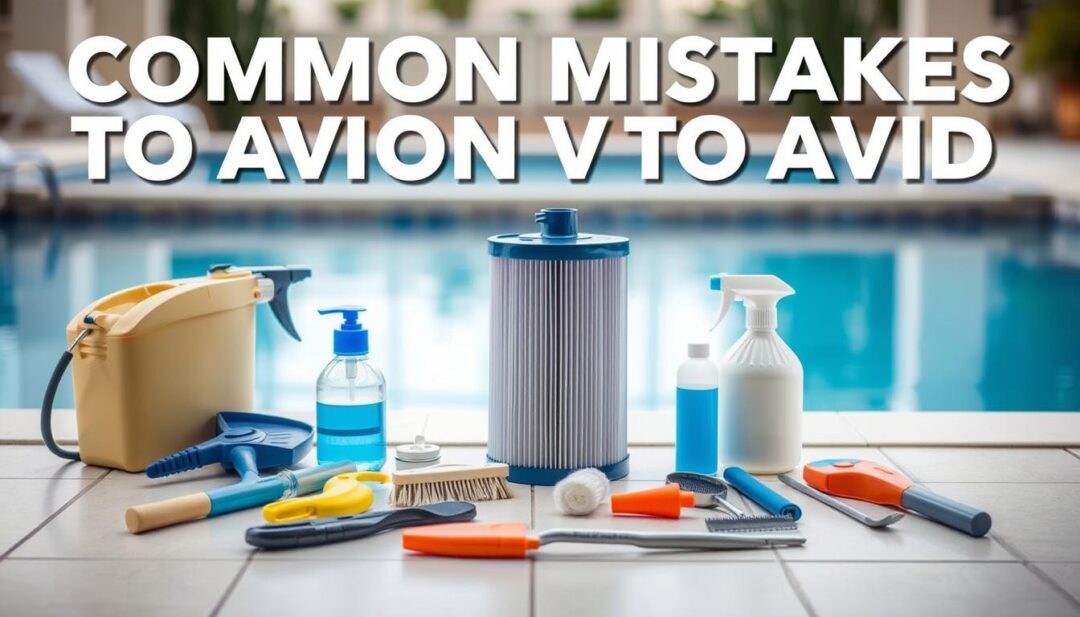
Chemical Mistakes
Using the wrong cleaning chemicals or concentrations can damage the filter or harm pool users. Always follow the manufacturer’s instructions for cleaning solutions, and ensure that the chemicals are compatible with your filter material.
Improper Handling and Storage
Improper handling and storage of the filter can lead to damage and contamination. Always handle the filter with care, and store it in a clean, dry environment to prevent bacterial growth and contamination.
By avoiding these common mistakes, you can ensure that your cartridge filter is cleaned effectively and safely, maintaining optimal pool performance and water quality.
Troubleshooting After Cleaning
Even after thorough cleaning, some problems may persist. If you’re experiencing issues with your pool after cleaning the cartridge filter, there are several areas to check to ensure everything is working correctly.
Poor Water Flow Issues
If you notice poor water flow after cleaning, check for blockages in the filter or plumbing. Ensure that the pump is working correctly and that there are no kinks or blockages in the pipes. A clogged skimmer or pump basket can also restrict water flow.
Persistent Pressure Problems
If pressure problems persist, inspect the filter for any remaining debris. Check the pressure gauge for accuracy and ensure it’s functioning correctly. Sometimes, the issue might be with the gauge itself rather than the filter.
Water Clarity Concerns
If the water clarity does not improve after cleaning, check the filter for proper function. Consider checking the pool’s chemical balance, as improper chemical levels can affect water clarity. Ensure that the filter is properly seated and secured to prevent leaks and maintain system efficiency.
By addressing these common issues, you can ensure that your pool remains clean and safe for use. Regular maintenance and troubleshooting can help prevent more significant problems from arising.
Maintaining Your Cartridge Filter Between Cleanings
Proper upkeep of your cartridge filter between cleanings can significantly impact your pool’s overall health. Regular maintenance ensures that your pool water remains clean, safe, and clear for swimming.
Regular Monitoring Tips
Monitoring your cartridge filter’s performance regularly is crucial. Check the pressure gauge frequently, as increased pressure can indicate a dirty filter. Additionally, inspect the filter for any visible signs of wear or damage. Regular monitoring helps in identifying issues early, preventing major problems.
It’s also essential to check the pool water quality regularly. Test the water for pH, alkalinity, and calcium hardness levels. Imbalanced water chemistry can affect the filter’s efficiency and overall pool health.
Preventative Maintenance Schedule
Establishing a preventative maintenance schedule is vital for the longevity of your cartridge filter. Regularly cleaning the filter, checking for worn-out parts, and ensuring the pool’s plumbing system is leak-free are essential tasks.
- Weekly: Check and record the pressure gauge reading.
- Bi-Weekly: Inspect the filter for damage or wear.
- Monthly: Perform a thorough cleaning of the filter.
By following this schedule, you can prevent major issues and ensure your cartridge filter operates efficiently.
Using Pool Chemicals Properly
Using pool chemicals correctly is crucial for maintaining water quality and filter effectiveness. Always follow the manufacturer’s instructions for chemical dosing to avoid over-chlorination or under-chlorination.
| Chemical | Recommended Level | Effect of Imbalance |
|---|---|---|
| pH | 7.2 – 7.8 | Eye irritation, equipment damage |
| Alkalinity | 80 – 120 ppm | pH fluctuation, corrosion |
| Calcium Hardness | 200 – 400 ppm | Scaling, corrosion |
Proper chemical balance not only ensures a safe swimming environment but also prolongs the life of your cartridge filter.
“Regular maintenance of your pool’s cartridge filter is not just about keeping the water clean; it’s about ensuring the longevity of your pool equipment and the health of your swimmers.”
When to Replace Instead of Clean Your Filter
Replacing your pool cartridge filter at the right time is essential for optimal pool performance. While regular cleaning can extend the life of your filter, there are instances where replacement is the more cost-effective and efficient option.
Signs of Filter Deterioration
Several signs indicate that your cartridge filter is deteriorating and needs to be replaced. These include visible damage to the filter element and persistent performance issues despite regular cleaning.
Physical Damage Indicators
Visible tears, holes, or other damage to the filter element are clear indicators that it’s time to replace the filter. Inspect your filter carefully after cleaning to identify any potential damage.
Performance Issues
If you notice persistent issues with water flow, pressure, or clarity despite regular cleaning, it may be a sign that the filter needs to be replaced. These issues can lead to decreased pool performance and potentially harm the pool equipment.
Average Lifespan of Cartridge Filters
The average lifespan of cartridge filters varies depending on usage and maintenance but typically ranges from 3 to 4 years. Regular monitoring and maintenance can help extend the life of your filter.
Cost Analysis: Replacement vs. Continued Cleaning
When deciding whether to replace or continue cleaning your filter, consider the costs involved. A cost analysis can help determine the most cost-effective option, taking into account factors like the cost of cleaning solutions and replacement filters.
| Factor | Cleaning | Replacement |
|---|---|---|
| Cost | $X (cleaning solutions) | $Y (new filter) |
| Time | Several hours | Less than an hour |
| Effectiveness | Temporary solution | Permanent solution |
Conclusion
Properly cleaning your pool cartridge filter is crucial for maintaining clean and safe pool water. Understanding what is the best way to clean pool cartridge filters can help you keep your pool in top condition.
By following the steps outlined in this article, you can ensure your cartridge filter is cleaned effectively. Regular maintenance, including rinsing and deep cleaning, will help extend the life of your filter and keep your pool water crystal clear.
Some valuable pool filter cleaning tips include regularly monitoring your filter’s performance, using the right cleaning solutions, and avoiding common mistakes like using a pressure washer. By staying on top of filter maintenance, you can enjoy a cleaner, healthier pool all season long.

